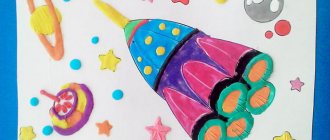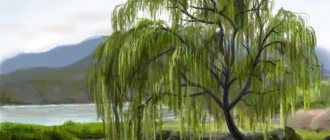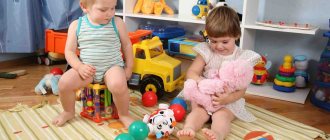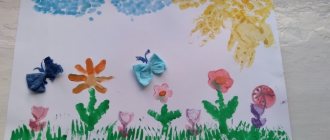Plasticineography classes are not only an effective method for developing fine motor skills in children, regardless of how old they are, but also allow primary schoolchildren to get rid of physical and mental stress.
Modeling from plasticine can also help a child adapt to kindergarten, becoming a favorite hobby for a growing person, with the help of which he can express the emotions that accumulate during the day, relieving the central nervous system and preventing the occurrence of neuroses.
The benefits of plasticineography
Plasticineography is a creative process during which children create three-dimensional pictures from plasticine , without using classic drawing tools - brushes, paints or pencils. For the working surface, sheets of paper, A3 size or larger, or thick cardboard are usually used.
Plasticineography for children is very useful due to its positive effect on their mental and physical development
Regardless of how old the child is, 2 or 8, the type of arts and crafts in question has a positive effect not only on his mental, but also physical development:
- filling the cognitive needs of children (especially important for children from 2 to 4-5 years old);
- acquiring the ability to navigate in the horizontal plane;
- formation of the creative component of the personality of a growing person (awakening interest in creativity, understanding the algorithm of the creative process, and so on);
- development of fantasy;
- development of fine motor skills of the hands (positively affects the child’s speech and overall development);
- broadening one's horizons;
- increasing the sensitivity of tactile perception;
- expansion of vocabulary (if the child already knows how to speak) or stimulation of speech (if the child does not yet speak due to age or developmental delay);
- instilling perseverance, accuracy, and independence in the child during the work process.
Plasticineography for children - step-by-step master class and photos
There are three flowers here. The first was made using the mosaic technique, for the second the contour technique was used, and for the third, mixing was used. Look how the children created such a beautiful picture. You can use ready-made templates for plasticine printing. Parents will print out such blanks by choosing the design they like on the Internet. Now let the child divide the plasticine into small pieces and roll balls from these blanks. In this way, the children will develop their tactile sensations and fine motor skills. Let the child now place balls of the same color on the first petal, filling it all in this way.
Then you can move on to the next petal. This way the child will decorate the entire flower. Decorating the second flower should begin by making sausages, and then filling its petals, drawn in the shape of hearts, with them. The flagellum is located clockwise.
If the length of the plasticine flagellum is not enough, then the child will make the same one, fasten the ends of these two sausages and continue his work.
For the next flower, you need to mix plasticine of different colors and attach it without going beyond the outline. You can first make the background of the flower using plasticine, then attach a lot of other flowers here, smearing it. The child will make sausages from green plasticine and fill the leaves of the flower with them.
- See also how to make a dinosaur from plasticine
Goals and objectives
The goals and objectives of plasticineography classes vary depending on the age of the child and the characteristics of their development.
At the age of 2-3 years
Plasticineography for children 2-3 years old should be aimed at developing fine motor skills. This will help the child not only develop physically correctly, but also stimulate his speech skills.
Adults, when asking children to create pictures from plasticine, should not just give a task, but use various methods to awaken the child’s creative abilities and his interest in the work process (for example, come up with a fairy tale, including in the plot an object that the child will then sculpt.
It could be a flower, an ax or a hat - something consisting of a minimum number of parts and not requiring a lot of time to create).
Since children at an early age are not able to independently come up with a task for plasticineography, and quickly lose interest in the work process if they understand that they are left to their own devices, an adult should set a clear task for them at the beginning of the lesson.
Plasticineography for children 2-3 years old should be easy to perform
Control and assistance from an older friend should be aimed at developing the child’s accuracy, perseverance and concentration on the sequence of actions.
Using plasticineography, you can also teach a child to navigate on paper , each time describing the location of the next part of the object being created. For example, it is important for children 2-3 years old to say where the left side is and where the right is, to prompt and guide their hands to the desired edge of the working surface.
When the young creator begins to better navigate the horizontal plane, the adult should begin to give instructions verbally, giving the child the opportunity to independently determine the place where the next detail of the final image needs to be placed.
4-5-6 years
Plasticineography for children 4-5-6 years old should be aimed at improving skills in working with plasticine. At this age, the younger generation begins to develop an interest in visual arts.
By the age of 6, tasks on plasticine applications can become more complicated.
If parents support their child in a timely manner and take action to unlock his creative potential, they will not only be able to strengthen the psycho-emotional connection with their baby, becoming his support and support, but will also give him the opportunity to try himself in art.
Modeling from plasticine for children 4–6 years old is also useful because it effectively develops the eye and improves hand coordination. This not only makes the child more physically developed, but also has a beneficial effect on the formation of neural connections in his brain.
At this age, children prefer to work collectively, which means that plasticineography for them in this case will be an opportunity to improve their communication skills with other members of society - it will teach them to explain their intentions, prove they are right, or correctly express disagreement.
7-8 years
Plasticineography for children 7-8 years old, its main goal involves instilling in younger schoolchildren new sculpting skills - pressing, smearing, rolling, squeezing out of syringes.
Already possessing the basic ability to create images from plasticine, young creators will be captivated by the process, discovering new facets of their usual form of creativity.
This will help them distract from negative thoughts, get rid of stress and release emotions associated with joining a new team at school, as well as accepting the great responsibility and demands placed on them by teachers and parents.
At the age of 7-8 years, children prefer to work individually. Creating pictures from plasticine will be an effective method for them to develop their imagination, as well as a vivid way of self-expression.
It is not necessary for younger schoolchildren to be given a clear plan of action; it is enough to simply limit them to a theme, for example, “Golden Autumn,” allowing them to independently come up with an idea and the main stages for their further work.
The benefits of using different drawing techniques in classes with children
Kids intuitively strive to diversify their activities, because they have so much to learn, so many things to learn! This is also justified from the point of view of benefits for the development of children. Changing educational and creative activities allows you to train various cognitive skills (memory, speech, thinking), awaken the ability to think outside the box, and imagination.
Drawing is one of the most beloved, accessible, and therefore popular types of creativity among children of all ages. At the same time, there are practically no restrictions in the visual arts: you can draw with pencils, or with your finger on foggy glass, or with sand, or plasticine. The process of developing fine motor skills using any of the listed techniques has its own characteristics. For example, using a pencil or brush prepares the hand for writing, and contact with sand gives a unique tactile sensation and calms the child. Modeling classes teach your fingers to be strong and neat, and most importantly, they give you endless scope for creativity.
General recommendations
Correctly organizing plasticineography classes for children can only be done taking into account the general recommendations:
- The total time for modeling from plasticine should be no more than 30 minutes. (otherwise the child’s attention will be distracted, and productivity will accordingly decrease);
- It is necessary to create pictures from plasticine in a well-lit place, a comfortable environment for the child, excluding the presence of distracting objects nearby, for example, a smartphone, computer, tablet, TV or toys;
- in classes with children 7-8 years old, it is recommended to use thick cardboard, since plain paper will be deformed when using the techniques of smearing, rolling and smoothing plasticine;
- It is recommended to cover the working surface with transparent tape before starting modeling (this will eliminate the possibility of greasy stains and streaks from plasticine);
- In order for the final image to retain its original appearance for as long as possible, it is recommended to cover it with colorless varnish in 2-3 layers;
- During the creative process, not only the basic working tools for plasticine printing, but also wet wipes, a knife or scissors, as well as sheets of thick paper (you can use it to correct the plasticine image) should be within reach of the child.
Materials for work
Proper organization of a lesson in plasticineography requires the presence of a basic set of working tools:
- Thick cardboard or large sheet of paper.
Materials and tools for working with palstiline
Depending on the age and practical skills of a particular child or group of children, on the working surface you can draw the outline of an object, the inside of which will be filled by the child.
- Set of multi-colored plasticine. It is not recommended to provide a child with more than 7-8 colors of plasticine, as this may cause distraction. The need to obtain a shade that is not in the presented set will stimulate the imagination of the young creator, as well as encourage him to experiment by mixing the viscous mass.
- Hand wipes and antiseptic. Necessary for removing plasticine residues from the skin of your hands.
- Stacks. Special small plastic knives designed for working with plasticine.
- Modeling board. On a separate wooden surface, the child will create a specific detail of the object by rolling, cutting, smearing plasticine, which will subsequently be transferred to cardboard or paper used as a base.
- Original image. If a child is given a task to create a specific picture, he should be provided with a final image, demonstrating what he should get as a result of his creative activity.
Drawing with plasticine: basic techniques
A number of techniques are already known to children, because drawing with plasticine is preceded by learning to sculpt.
Kids already know how to:
- roll up;
- roll out;
- flatten;
- pull out;
- give the desired shape to a piece of plasticine.
What skills do children acquire when learning plasticineography?
To draw with plasticine, children will have to learn:
- pinch off;
- smear;
- press in;
- smooth;
- mix colors;
- add texture using stacks.
There are many ways to create an image:
1. Direct . Different colors of plasticine are used. The most popular patterns are vegetables, leaves, mushrooms, and fish. Direct plasticineography is the first acquaintance with unusual drawing. Large and simple shapes are used, which are easy for even kids to work with.
2. Stained glass (reverse) . A drawing is applied to the plexiglass plate with a marker. The resulting contour is filled with plasticine. Reverse plasticineography is very effective. Very often, sour cream lids are used as a base.
3. Mosaic. The figure or design is created with multi-colored plasticine balls. Mosaic plasticineography is very simple. The secret to beautiful drawings is a good selection of colors and accuracy. An example of such a technique is the master class “Cockerel Fish”, the body of which is lined with mosaics.
4. Contour. This method is practiced by older children. The contour is filled with plasticine flagella, which are squeezed out using a syringe. The material must be heated. For this purpose, use either a microwave or hot water. A plasticine sausage is placed in a syringe without a needle and heated along with it.
5. Multi-layered. The material is applied with multi-colored strokes. The painting is created by layering. The result is a three-dimensional image. Like, for example, in a plasticine Easter card.
6. Textured. The convexity of the image varies. Children learn to create high reliefs, bas-reliefs and counter-reliefs. Textured plasticineography is one of the most difficult types, which is why it is taught to children in preparatory groups. Look how we made a fairy tale character - the Gruffalo.
7. Modular. They perform the elements separately using different techniques, and then build a single composition from them. For example, you can create a relief image from flagella, balls and sausages.
Using this technique you can create a wonderful underwater world.
The description is just an example; everyone will have their own fantasy underwater kingdom. See detailed instructions on how to make an underwater world from plasticine here.
To make corals and algae, you can mix colors to achieve beautiful tints. For example, blue, violet, blue, light green and dark green shades are suitable for making underwater plants. Corals and shells are sculpted from pink, yellow, and white plasticine.
When all the parts are ready, they are attached to a painted sheet of paper.
The craft helps you remember what the inhabitants of the underwater world look like and gives you an idea of scale. It uses figures of different shapes, so children will have to remember all the plasticineography techniques they have learned.
When creating a three-dimensional image, children are faced with the concept of measure. If you overload the picture with details, the whole effect will disappear. Instead of a bright and mysterious underwater world penetrated by the sun's rays, you will get a pile of plasticine figures.
The image contains many small and large details, so it will take a lot of patience and perseverance to reproduce all the inhabitants of the seabed.
This work is great for group work in a kindergarten group. Children learn the skills of teamwork, distribution of responsibilities, mutual assistance, and they will achieve excellent results!
Templates for plasticineography
Templates must be appropriate for the age of the students. If in the younger group preference is given to simple forms, then in the older groups complex images are created, with many elements, with different relief.
The templates are great for kids to get creative with. At the first stage, the contour is simply filled with plasticine. You can build the work differently and use a template on a sheet already covered with plasticine. A butterfly with a flower is made using this technique.
For this craft, leftover plasticine or old crafts are suitable, because you will need beautiful multi-colored tints.
Small pieces of plasticine need to be smeared on paper, trying to make as thin a layer as possible. Print a template that includes the butterfly outline, stem, three leaves, flower core and petals.
Cut out the printed parts from a plasticine-coated sheet. On white paper, use colored felt-tip pens or wax crayons to draw the earth with strokes. Glue the cut out colorful parts. Sculpt the body of a butterfly from plasticine and create a texture on it using a stack. Using a felt-tip pen, draw antennae for the butterfly and make plasticine eyes.
Pupils of the younger group can also cope with this craft. She teaches how to work with a template and trains the skill of smearing plasticine in an even, thin layer. Cutting out parts from a sheet covered with a layer of plasticine requires care and should not be rushed.
The “recycled” use of plasticine shows that opportunities for creativity can be found in already used objects and seemingly unnecessary items.
Plasticineography methods
Methods of plasticineography in the creativity of a particular child or group of children should be selected taking into account the skills of young creators, as well as their abilities and developmental characteristics.
The most commonly used of them are:
- Strokes. A small amount of plasticine is placed on the pad of the index finger or a special plastic spatula, after which it is applied to the work surface in the right place with sharp, randomly directed movements.
- Plasticine balls. Typically used when placing accents on a flat image (for example, the middle of a flower) or as basic shapes to fill the inner surface of an object schematically depicted on the working plane.
- Flattening the rolled balls. It is not recommended to use a lot of force when flattening the balls. Otherwise, the resulting figure will be deformed, thus losing its clear rounded shape.
- Smearing on the surface. This technique is used to create a background or fill the inside of a figure with colored material.
- Scratching patterns on plasticine. Patterns are created on a flattened piece of plasticine using a special plastic knife or tools with already formed threads.
- Rolling plasticine sausages. You can roll sausages both for placing them on the final image, and for the purpose of using them as a blank.
- Squeezing plasticine out of a syringe. For extrusion, it is recommended to use a special syringe, which allows you not only to easily extrude thin strips of plasticine, but also to remove the remaining working material from the main body of the tool.
Plasticineography for children - what is it?
Depending on the age of the children, it is recommended to use certain plasticineography techniques.
Experts believe that from the age of three, a child can be taught plasticineography, first showing simple modeling techniques.
Here's what you can teach kids:
- smudging;
- stretching and flattening;
- rolling out.
Follow the following instructions:
- To use smearing, you must first heat the clay in warm water, then smear it with your fingers on a smooth surface.
- You can roll it out using your palms or using a plastic or silicone rolling pin. This technique requires certain skills and strength.
- Using flattening and stretching, children will be able to make a sausage, pancake, cylinder and other figures from plasticine, which can then be used to create paintings.
Kids need to be given time to rest so that they like the type of activity, and then they want to continue creativity.
These techniques are recommended for children from 3 to 5 years old. And from 5 to 7 years old they can already use more complex techniques. This:
- topping;
- smoothing;
- pressing;
- pressing, smearing;
- mixing.
Let's take a closer look:
- Smoothing will help create the background of the future painting. The child will wet his fingers in water, take a little plasticine and smear it over the surface. To connect the elements of the picture with each other, you can use the technique of pressing and smearing.
- Using pinching, the child will make details for the picture and various decorative elements for it. After plasticine is applied to the picture, the child will pinch it with his fingers in some places where the artistic design requires it.
- By mixing, plasticine of an interesting color is obtained. If you take light and dark shades and only slightly crush them in your hands, you will get a marble effect.
- As a result of pressure, the child will attach parts of the image.
- That's how many opportunities plasticineography gives. For children, it is recommended to use different types of work. Look at what types of plasticineography are used.
- Stained glass plasticine involves attaching plasticine to the wrong side of the base. At the same time, it will be transparent. So, you can take plexiglass or plastic. First you need to draw a picture using a marker, and then, on the other side, cover its parts with plasticine of a certain color.
- Another method of plasticineography is called mosaic. Invite your child to roll several plasticine balls of different colors. Children will then fill the pre-created space with these elements. The finished works resemble mosaic techniques.
- Modular plasticineography involves the use of various elements. These can be flat cakes, braids, balls, sausages, cylinders and other plasticine figures.
- Show your child what contour plasticineography is. As the name implies, some part of the drawing needs to be sculpted along the contour. First, the child will draw a drawing with a marker. Then he will roll up thin strands and place them on these contours. To do this, you can use a syringe without a needle. First it is placed in warm water. When the mass becomes soft, you can squeeze it out of the syringe onto the contours.
- Textured plasticineography allows you to produce voluminous works. In this way you can create a bas-relief, a counter-relief, a high relief.
Now check out a hands-on tutorial that will help you implement some of the techniques.
Flowers
The easiest way to make a flower using plasticine printing:
- In the center of a sheet of paper or thick cardboard used, draw the outlines of an open flower (middle and petals).
- Using a small amount of yellow plasticine, rubbed over the middle of the flower, paint the inside area of the bud.
- Grind the red plasticine evenly, covering the inside of the drawn petals with it, without going beyond the middle.
- Twist several sausages from blue plasticine, and then use them to mark the boundaries of the flower. As an alternative to sculpting additional elements to create borders, the simplest rubbing of blue plasticine along the contour of the image using a finger or a special spatula is allowed.
- Cover the image with 2 layers of clear varnish, then let it harden on its own.
- Draw several thin lines from the middle of the flower by rubbing a small amount of plasticine, directing them to different petals.
Plasticineography for children on the theme “Spring”
Prepare everything you need, then it’s time to get down to business. It is better to first mark with a simple pencil where everything will be located. Then you show your child how to knead the plasticine and make it into something like melted snowdrifts. And from black he will create emerging islands of earth.
Let it be seen how the melt water flows. The baby will convey this using a strip of blue plasticine. From the same mass he will create clouds. Then you need to tear off several pieces from the white plasticine and create a semblance of buds from them. And the blossoming petals consist of three such blanks. All that remains is to make a sun and attach it to the top of the drawing. The result was a wonderful work using the plasticine technique.
If you and the children liked plasticine painting, spring will be captured in a very interesting way. Let the child create a three-dimensional picture in which it will be seen that buds are blooming and starlings are flying in. People build birdhouses for them. The sun shines brightly. Don't forget to tell your children about these signs of spring. Kids should know about this.
To do this kind of work, you first need to take a sheet of blue cardboard or paint it white so that it becomes this tone. But you can create a background using blue plasticine. Then, using flagella, the child will make an edging for the trunk and branches of the birch. He will cover the inside of the tree itself with white modeling material. You need to put a few strokes on it so that you can see that it is birch. Using green plasticine, the child will depict blossoming leaves.
Using black wax plasticine, children will make starlings, and their beaks will be made from red. The yellow sun is round, and its rays need to be made from plasticine, which is rolled between the palms. All that remains is to attach the birdhouse, and the painting, made using the plastinography technique, called “Spring,” is ready. The following work was done in mixed media. But mostly mosaic is used here.
From small pieces of plasticine that need to be rolled between the palms, the child will create birch trees and the sky. Look, different shades are used here and the work becomes extremely attractive.
Show the children how to first draw the horizon line, which in this case is wavy. Now the child will make grass below using green plasticine and plant flowers here.
Then you will need to draw an outline with a plastic knife to indicate where the tree trunks will be located. Between these marks, children will stick balls of white plasticine and alternate them with a small amount of black. Using green they will make a lush crown, and blue and blue will become a beautiful sky. But such work is more feasible for older children in kindergarten or younger schoolchildren. For very young children, we can recommend the following painting using the plasticineography technique. “Spring” is exactly what it’s called.
First, help your child outline the outlines of trees and flowers. Now give him wax crayons, let him use the brown one to make a trunk, and let the green one become a lush crown of the tree. From the same plasticine he will create grass and stems for flowers, and the blossoming parts will be made from bright orange plasticine. All that remains is to make the clouds and the sun.
Help your child expand his vocabulary and teach him to think figuratively. The following work will help with this. During the process of creating it and after that, the child will be able to come up with various stories and pronounce them out loud.
- To make a tree trunk, your child will roll sausages out of brown plasticine and attach them here. Then he will also make the tree branches, but they will be a little thinner. To make leaves, you need to tear off small pieces from green plasticine, roll them into balls and flatten them between your palms.
- To make the sun, have your child take a large ball of plasticine, make a circle out of it, then turn it into a pancake. He will stick the sun into the corner of the work, and then using the smearing technique, he will begin to create rays. This work will be easy on a background of blue plasticine. Since these two materials will help the finger glide better.
- In the same way, the child will make white clouds. For the butterfly, they use the mixing technique to create such lacy wings. To make flowers, you can glue glitter onto a plasticine background. The stems will be made from thin strips of this material. All that remains is to create a hardworking ant, a bee, the work is completed.
See what works can be recommended for children of certain ages. The younger the children, the simpler the samples. But they still turn out to be very interesting.
- See also, master class on how to draw spring
Space
The following option for creating an image of space using plasticine is suitable for children of any age. For children under 3-4 years old, it will become a full-fledged craft, while for older children such a picture will become a background image, implying further refinement of the drawing with details.
Step by step execution:
- Using blue and deep blue plasticine, make multiple strokes over the entire area of the sheet of paper being used so that they look like a single whole.
- Roll small balls from white plasticine. Place them randomly on a blue-blue background, then slightly flatten them with your finger (celestial bodies).
How to make pizza from plasticine?
Take everything you need, this is:
- sheet of cardboard;
- plasticine of the desired colors;
- syringe without needle;
- stacks for modeling.
Have your child draw a circle on a piece of cardboard. These will be the outlines of the future pizza. Now using red-brown color he will make the background. This is ketchup. You can also use dark red color for it. Make the sides for the pizza, the base is ready.
Then you need to make mushrooms from white plasticine. To do this, the child will tear off two pieces from the mass, turn them into two ovals, then give them the desired shape and flatten them. Each mushroom consists of a cap and a stem.
The next thing to decorate the pizza is sausage. To do this, you first need to fashion circles from pink plasticine, then make ropes from it and frame these blanks with them. The child will make circles of different sizes from white plasticine and glue them onto this improvised sausage.
The next thing that decorates this work using the plasticine technique is greenery. Make leaves from plasticine of the appropriate color, using a stack, add veins to them.
For the next part of the work, a piece from Lego Duplo will be useful; with it you will make a hole in the cheese. And the child will create it from yellow plasticine, which needs to be rolled out into a layer or will do it with the help of his fingers.
This tool will also help to make dark olives, which are made from black plasticine, perfectly smooth.
The photo clearly demonstrates how such plasticineography is created. Let the child make ropes from red plasticine, then roll them into snakes and glue these streams of ketchup in place. As you can see, the olives can be cut out from the inside to create holes.
But you can create not only food for dolls, but also to develop a sense of beauty. To do this, see how to make various paintings using this interesting technique. It will be enough to buy wax plasticine so that you can create such masterpieces.
To ensure the most longevity of the painting, when it is ready, coat both sides with varnish and let it dry.
Animals
To create an image of an animal using plasticine, children will need pre-prepared templates. The inner surface of the drawn animal is filled with balls of plasticine (the color of the working material corresponds to the shade of the animal’s skin), placed closely, or painted over by evenly rubbing it or creating numerous strokes.
Classes on creating images for children from 2 to 8 years old using plasticine should be regularly conducted under the supervision of parents or teachers of preschool and school institutions.
Plasticineography helps representatives of the younger generation to reveal their creative potential, develop taste in art, improve physical development, and at the same time normalize the state of their own nervous system, thereby minimizing the occurrence of depressive mood.









